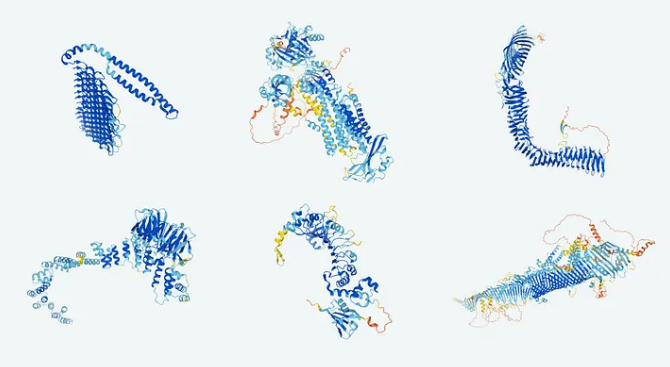AlphaFold: Revolutionizing Protein Structure Prediction (GS Paper 3, Science)

The Protein-Folding Problem
- Proteins are vital to all cellular processes, performing a multitude of functions within living organisms.
- These functions are determined by their three-dimensional shapes, which are dictated by the sequence of amino acids that make up each protein.
- Understanding how a protein folds into its functional shape from its amino acid sequence has been one of the most significant challenges in biology, known as the protein-folding problem.
- Traditional methods like X-ray crystallography and nuclear magnetic resonance spectroscopy have been used to determine protein structures, but these methods are both time-consuming and expensive, limiting the speed of scientific discovery in fields such as medicine and agriculture.
The Introduction of AlphaFold
- In a groundbreaking development, DeepMind, a subsidiary of Alphabet, created AlphaFold to address the protein-folding problem.
- AlphaFold is an artificial intelligence (AI) system that uses deep learning to predict the three-dimensional structures of proteins based on their amino acid sequences.
- The development of AlphaFold began in 2016, with significant advancements demonstrated during the Critical Assessment of Structure Prediction (CASP) competitions.
- By 2020, AlphaFold 2 had achieved a level of accuracy that was unprecedented, significantly outperforming other methods and heralding a new era in structural biology.
Expansion and Evolution: AlphaFold 3
- The progress continued with the release of AlphaFold 3 in 2024, developed in collaboration with Isomorphic Labs.
- This version expanded the predictive capabilities beyond proteins to include other biological molecules such as DNA, RNA, and small molecular ligands.
- The advancements in AlphaFold 3 have the potential to transform various fields, including drug design, genomics, and the development of sustainable materials, by providing detailed molecular structures that are critical for understanding and manipulating biological processes.
AlphaFold Database
- To maximize the impact of AlphaFold, DeepMind partnered with EMBL’s European Bioinformatics Institute to create the AlphaFold Protein Structure Database.
- This database, first released in 2021, initially contained over 350,000 protein structures.
- By 2022, the database had grown to include over 200 million structures, making it one of the most comprehensive resources available for researchers.
- The database is freely accessible, allowing scientists worldwide to utilize the wealth of structural information in their research, accelerating discoveries across numerous scientific disciplines.
How AlphaFold Works
- AlphaFold's success lies in its sophisticated use of machine learning.
- The AI system is a deep learning algorithm, specifically an artificial neural network with multiple layers of nodes.
- These nodes are interconnected and can be trained to recognize patterns in large datasets.
- In the case of AlphaFold, the training data consisted of protein structures from the Protein Data Bank (PDB), which includes over 215,000 experimentally determined macromolecular structures.
Training and Prediction
- AlphaFold's neural network was trained to understand the relationships between amino acid sequences and their corresponding three-dimensional structures.
- When given a novel protein sequence, AlphaFold aligns it with similar sequences to identify conserved regions that likely interact and are thus close in the 3D structure.
- The AI then predicts the protein's 3D shape based on these patterns.
- The predictions are generated quickly, often within minutes, and AlphaFold can operate without relying on template structures, making it a powerful tool for discovering new protein folds.
Confidence Metrics
- A crucial aspect of AlphaFold is its ability to provide confidence metrics for its predictions.
- These metrics include pLDDT (predicted Local Distance Difference Test), pTM (predicted Template Modeling score), and PAE (Predicted Aligned Error).
- These scores help researchers assess the reliability of different parts of the predicted structure.
- If AlphaFold is uncertain about a specific region, it provides a lower confidence score, enabling scientists to interpret the results critically and decide where further experimental validation might be needed.
Impact and Future Prospects
- AlphaFold represents a monumental leap in molecular biology, offering a tool that significantly accelerates the process of understanding protein structures.
- Its impact extends beyond fundamental research to practical applications in medicine, where accurate protein models can aid in drug discovery and the design of new therapeutics.
- In agriculture, it can help in the development of crops with improved traits.
- The ability to predict the structures of other molecules with AlphaFold 3 further broadens its applications, potentially revolutionizing fields like genomics and materials science.
Conclusion
- By democratizing access to detailed protein structures through the AlphaFold Protein Structure Database, DeepMind has empowered researchers globally, fostering an environment of collaboration and rapid scientific progress.
- The continued evolution of AlphaFold promises to unlock new frontiers in our understanding of biology, paving the way for innovations that can address some of the most pressing challenges in health, sustainability, and beyond.


